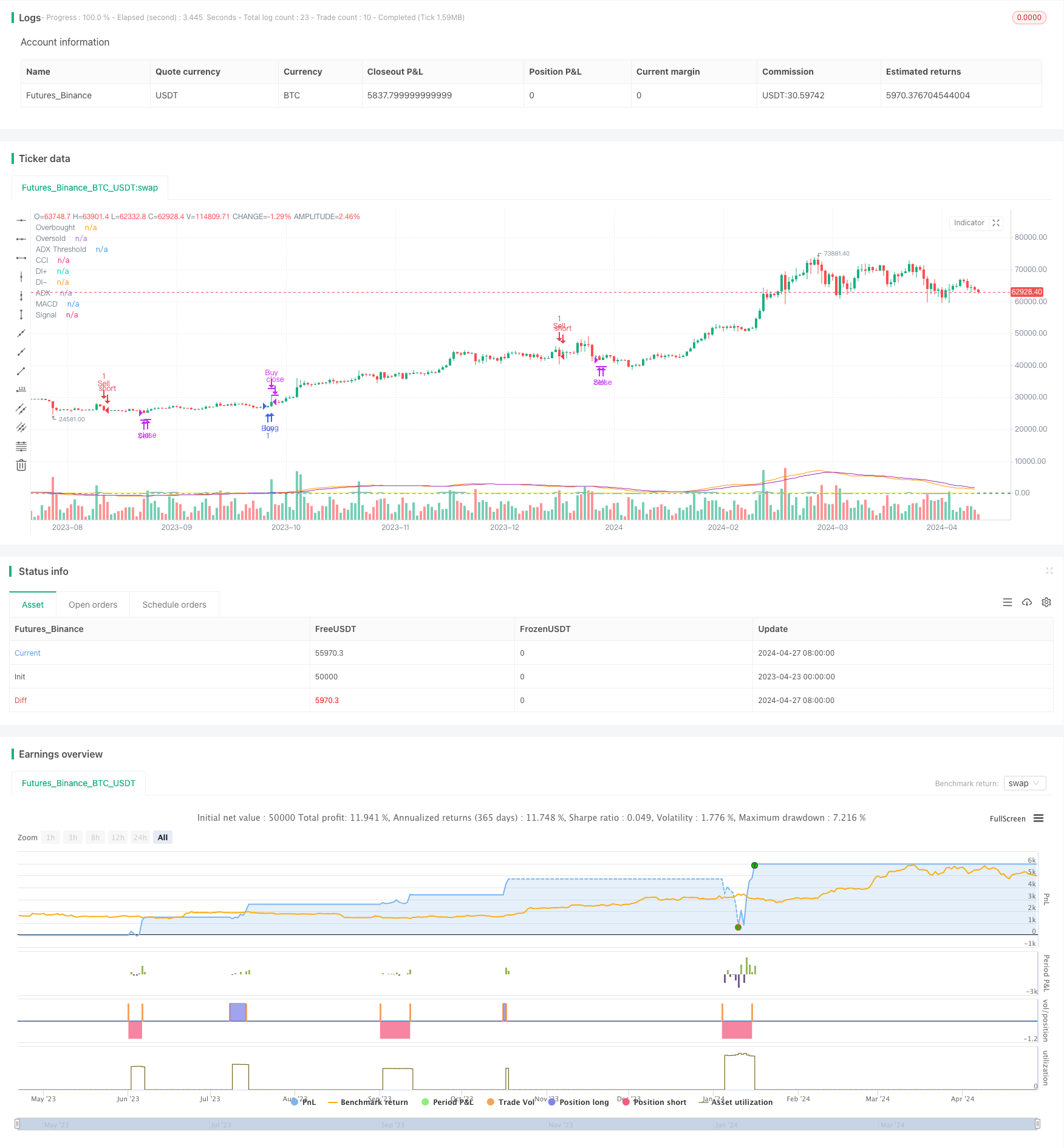
概述
该策略利用多个技术指标的组合来生成交易信号。它结合了顺势指标(CCI)、趋向指标(DMI)、移动平均线趋势指标(MACD)和平均方向指数(ADX)来确定买卖时机。当CCI、DMI、MACD和ADX的组合条件满足时,策略会产生买入或卖出信号。该策略旨在捕捉市场趋势,同时考虑了动量和波动性因素。
策略原理
- CCI指标用于判断市场超买和超卖状态。当CCI值穿过超卖水平时,表明市场可能出现反转,策略会考虑买入信号。当CCI值穿过超买水平时,表明市场可能出现回调,策略会考虑卖出信号。
- DMI指标用于判断市场趋势的方向和强度。当+DI线高于-DI线时,表明市场处于上升趋势,反之则表明下降趋势。策略会根据DMI的趋势方向来确定买卖方向。
- MACD指标用于判断市场的趋势和动量。当MACD线高于信号线时,表明市场处于上升趋势,反之则表明下降趋势。策略会根据MACD线和信号线的相对位置来确定买卖时机。
- ADX指标用于判断市场趋势的强度。当ADX值高于某个阈值(如20)时,表明市场趋势较强,策略会更倾向于跟随趋势进行交易。
- 策略综合考虑以上四个指标的信号,当它们共同满足特定条件时,会产生买入或卖出信号。买入条件包括CCI穿过超卖水平、+DI高于-DI、MACD线高于信号线以及ADX高于阈值。卖出条件则相反。
策略优势
- 多指标组合:该策略综合运用了多个技术指标,从不同角度评估市场状况,提高了交易信号的可靠性。
- 趋势跟踪:通过DMI和MACD等指标,策略能够有效捕捉市场趋势,在趋势方向上进行交易。
- 波动性考量:CCI指标和ADX指标的引入,使得策略在判断买卖时机时考虑了市场的波动性因素,避免在波动较大的市场中频繁交易。
- 风险管理:策略设置了明确的进场和出场条件,有助于控制风险和管理仓位。
策略风险
- 参数敏感性:策略的表现可能对指标参数较为敏感,不同参数设置可能导致不同的交易结果。需要对参数进行优化和测试,以找到适合特定市场的最佳参数组合。
- 市场适应性:策略在某些市场状况下可能表现欠佳,如震荡市或趋势反转期。需要对策略进行适当调整,以适应不同的市场环境。
- 滑点和交易成本:频繁的交易可能带来较高的滑点和交易成本,影响策略的整体表现。需要考虑优化交易频率和控制交易成本。
策略优化方向
- 参数优化:对策略中各指标的参数进行优化,如CCI的时间周期、DMI的时间周期、MACD的快慢线周期和ADX的阈值等,以找到最佳的参数组合,提高策略的表现。
- 加入其他指标:可以考虑引入其他技术指标,如相对强弱指数(RSI)、随机振荡器(KDJ)等,以进一步完善交易信号的生成条件,提高策略的可靠性。
- 风险管理优化:优化策略的风险管理,如引入止损和止盈机制、动态调整仓位大小等,以更好地控制风险和保护账户安全。
- 适应性优化:针对不同的市场状况,如趋势市场、震荡市场等,对策略的买卖条件进行适当调整,以提高策略在不同市场环境下的适应性。
总结
该策略通过结合CCI、DMI、MACD和ADX等多个技术指标,生成买卖信号,以捕捉市场趋势和把握交易机会。策略的优势在于多指标组合、趋势跟踪和波动性考量,但同时也存在参数敏感性、市场适应性和交易成本等风险。未来可以通过参数优化、加入其他指标、风险管理优化和适应性优化等方面对策略进行改进,以提高其稳定性和盈利能力。总的来说,该策略为量化交易提供了一种多维度分析市场的思路,但仍需要在实践中不断优化和完善。
策略源码
/*backtest
start: 2023-04-23 00:00:00
end: 2024-04-28 00:00:00
period: 1d
basePeriod: 1h
exchanges: [{"eid":"Futures_Binance","currency":"BTC_USDT"}]
*/
//@version=5
strategy("CCI, DMI, MACD, and ADX Strategy", overlay=true)
// Define inputs
cci_length = input(14, title="CCI Length")
overbought_level = input(100, title="Overbought Level")
oversold_level = input(-100, title="Oversold Level")
adx_threshold = input(20, title="ADX Threshold")
macd_fast_length = input(24, title="MACD Fast Length")
macd_slow_length = input(52, title="MACD Slow Length")
macd_signal_length = input(9, title="MACD Signal Length")
// Calculate CCI
cci_value = ta.cci(close, cci_length)
// Calculate DMI
[di_plus, di_minus, adx_line] = ta.dmi(14, 14)
// Calculate MACD
[macd_line, signal_line, _] = ta.macd(close, macd_fast_length, macd_slow_length, macd_signal_length)
// Define buy and sell conditions
buy_signal = ta.crossover(cci_value, oversold_level) and di_plus > di_minus and macd_line > signal_line and adx_line > adx_threshold
sell_signal = ta.crossunder(cci_value, overbought_level) and di_minus > di_plus and macd_line < signal_line and adx_line > adx_threshold
// Define exit conditions
buy_exit_signal = ta.crossover(cci_value, overbought_level)
sell_exit_signal = ta.crossunder(cci_value, oversold_level)
// Execute trades based on conditions
strategy.entry("Buy", strategy.long, when=buy_signal)
strategy.close("Buy", when=buy_exit_signal)
strategy.entry("Sell", strategy.short, when=sell_signal)
strategy.close("Sell", when=sell_exit_signal)
// Plot CCI
plot(cci_value, title="CCI", color=color.blue)
// Plot DMI
plot(di_plus, title="DI+", color=color.green)
plot(di_minus, title="DI-", color=color.red)
// Plot MACD and Signal lines
plot(macd_line, title="MACD", color=color.orange)
plot(signal_line, title="Signal", color=color.purple)
// Plot ADX line
plot(adx_line, title="ADX", color=color.yellow)
// Plot overbought and oversold levels
hline(overbought_level, "Overbought", color=color.red)
hline(oversold_level, "Oversold", color=color.green)
// Plot ADX threshold
hline(adx_threshold, "ADX Threshold", color=color.gray)
相关推荐